 Case report
Case report
Tides Effects on Short-Time Freshwater Habitat Modifications of Lower Mekong River Delta (SE Vietnam)
Górniak Andrzej1*, Trần Xuân Dũng2, Võ Lương Hồng Phước2
*1University of Białystok, Department of Freshwaters Ecology, Białystok, Poland
2Vietnam National University of Ho Chi Minh City, University of Science, Department of Oceanology, Meteorology and Hydrology, Vietnam
Górniak Andrzej, University of Białystok, Department of Freshwaters Ecology, Białystok, Poland,
Received Date:May 13, 2024; Published Date:May 16, 2024
Abstract
Evaluation of short-time freshwater habitat fluctuations was provided in the period October 2019 - February 2020 in the Mekong River delta in Vietnam. Three phases of water flow direction were documented in the diurnal tide cycle. In the middle - “stagnation” state, a daily maximal oxygen concentration in the river occurs, regardless of the sun’s position above the horizon. Each tide cycle also creates a periodic water mass friction zone in the nearshore part of the riverbed and increases the sedimentation rate within the opposite direction of water mass flow. The biotic effects of freshwater habitat modification in the river branches are discussed.
Keywords: River; delta; ecohydrology; tides effects; phytoplankton
Introduction
Many large tropical rivers have a delta, and this character is the result of strong sea tides, a large load of suspended solids conducted from the catchment area [1]. Water salinity changes in a daily cycle, typical for estuaries, and the modification of the nature of the water flow in the riverbed significantly changes the habitat conditions of hydrobionts. The appearing changes in the habitat’s physical and chemical conditions translate into the river ecosystem’s biotic structure and are often overlooked in the current models of river functioning [2]. Due to technical difficulties and strong, centuriesold anthropogenic transformations of agricultural lands that are attractive for agriculture, the areas of river deltas are currently the least known in hydrobiology [3]. Delta regions are an ideal object for ecohydrological analysis because the natural hydrological instability repeated in the 24-hour cycle creates specific and unique biological systems. To learn about the ecohydrological aspects of the river’s functioning in the delta area in a tropical climate, research was carried out at the turn of 2019 and 2020 in the Mekong River delta in Vietnam. Field observations and basic water parameter measurements were aimed at showing the physical specificity of flowing waters and the effects of habitats in the daily cycles of the water environment, not much documented earlier.
Case Presentation
The Mekong River Delta is located at the final, nearly 300 km, with over 4,000 km of its course, mainly in Cambodia and Vietnam. In the lower section of the Mekong River, the two natural arms of the river (Tien River and Bassac Rivers) gradually separate into nine continuously functioning river beds, with a mean annual discharge 13,000 m3s [4]. In addition, the surface water system has been anthropogenically enriched with a network of canals, built over 3000 years of man settlement in this area [5]. There are two or three high water levels and ebbs in river branches and canal system of delta per day, with amplitude higher than 4 meters near sea area up to 1-2 m in Cambodia and Vietnam border region. Observed daily water level amplitude is higher in dry periods (November- May) than in times of monsoon rains [6]. Oppositive changes in water flow direction have a place each day in river branches with high morphological differences of maximal channel depth in places exceeding 30-35 m [7]. The banks of the river canals are abundantly colonized by water hyacinth mats with variable surface and density, regardless of hydrotechnical transformation degree. A high suspended material transport, near 100-200 mg·dm-3, is typical for the lower Mekong River, as long-term analysis indicated [8].
The field research was provided in the period October 2019 - February 2020 on the river stretch between My Tho and Cai Be in Vietnam (Figure 1) in a period of low discharge and drought (MRC, 2021). Presented in paper data are typical for the late wet period and the beginning of the dry season. The diurnal cycle of the water level was monitored over a few weeks period, as well as water direction flow, water temperature at 10 cm depth, Secchi disc visibility, water conductivity, and oxygen concentrations. Measurements were made manually, using an HQ40D Multi Meter (Hach-Lange GmbH), with 1–2-hour intervals, according to water level change rates. In the each of observation companies in Cai Be station (Figure 1, location B) a strong dynamic of water level was observed, with a diurnal amplitude higher than 2.1 m (Table1) compared to the 1.3 m amplitude noted in My Thuan hydrological station located near 30 km upstream (Figure 2). That is agree with the typical decrease water level amplitude tendency with sea distance increasing [9,10]. Short-time changes in river water level induced by tides provide periodical drying of bottom sediments from peripheral bed zones. The changes in the river water level were accompanied by changes in the flow direction. The change of the water flow direction in the riverbed does not take place frontally, but each time, there are three phases (Figure 3).
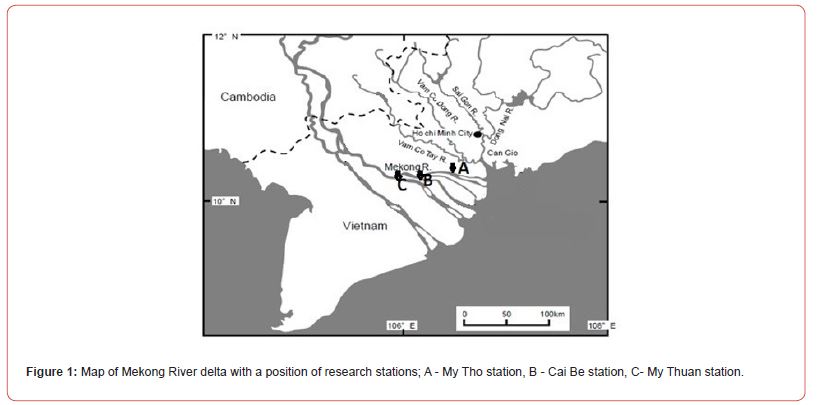
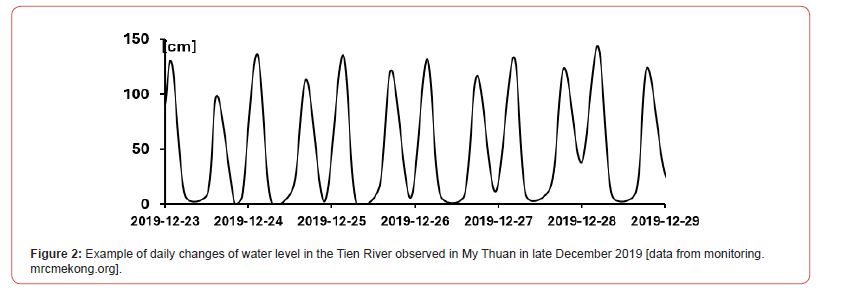
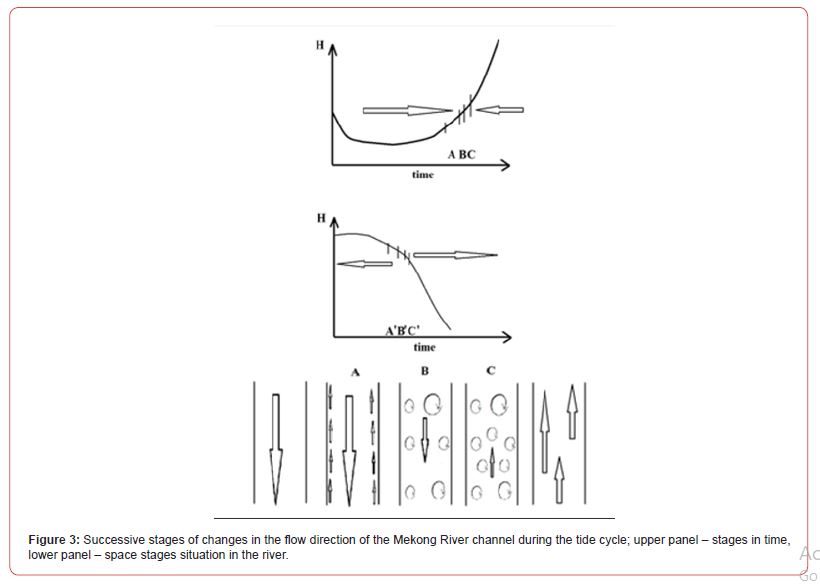
Near 20-30 minutes after reaching the minimum or maximum water level and earlier phase of local water eddies without of visible water flow in the river. A harbinger of a change in the direction of water flow, in addition to changes in the river’s water level, is the appearance of a near bank stream, 2 - 3 m wide, with a gradually increasing flow velocity. The occurrence of a “backflow” lasts 15-20 minutes (phase A) until the moment of the formation of phase B with local surface water vortices and no clear direction of the water flow. The changing water level of the river due to the increase of tide leads to a slow flow of water across the entire width of the river with disappearing eddies (phase C). The observations made at various branches of the lower Mekong River and Dong Nai River show that the duration of the distinct phases of the change in the direction of the river flow is similar, and only the C phase is characterized by a slightly shorter time. The generalized cycle of water level and river flow direction changes during tides is presented in Figure 4. The described phenomenon of periodicity entails a number of additional processes modifying the nearshore freshwater habitat of rivers. Short-term changes in the water level cause slight changes in river water conductivity, mainly because of increased resuspension of bottom sediments and supply with interstitial waters (Table 1).
Table 1:Observation results of lower Mekong River (Tien River branch) in Cai Be in the period November 2019 - January 2020; EC – electrical conductivity. In data for diurnal oxygen amplitude, added mean values of oxygen concentration increase during stagnations phase B in Figure 3, low panel).

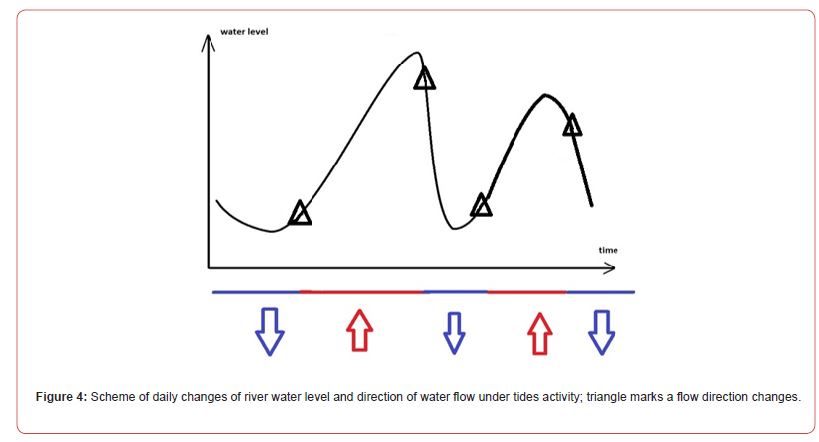
Another tide effect is the occurrence of the daily maximum oxygen concentration in the river water during the “stagnation” (C phase on Figure 3). During this brief time concentration of oxygen in river water increases in mean 0.3-0.4 mg dm-3 (Table 1), which corresponded to an increase in water oxygen saturation by 8-12%. With a stable flow of water in the river, such a maximum usually occurs in the afternoon [9], while in rivers under the influence of tides, it may appear at various times of the day, depending on the position in the sun and moon cycle. It turns out that even a brief period with the elimination of the visible water flow is enough to significantly increase of photosynthetic algae efficiency in conditions of significant insolation of the rivers of the tropical zone. It is also favored by the domination of the fine silt fraction in the suspension, which quickly sediments while reducing the water flow velocity and increasing the range of the photic zone. According to Doods et al., [11], the deltas of large rivers under tides are heterotrophic and can be autotrophic on a daily scale. The periodic intensive river phytoplankton growth currently increases the local density of small planktivorous fish - phytoplankton consumers, and therefore local fishers at this time go out to catch them.
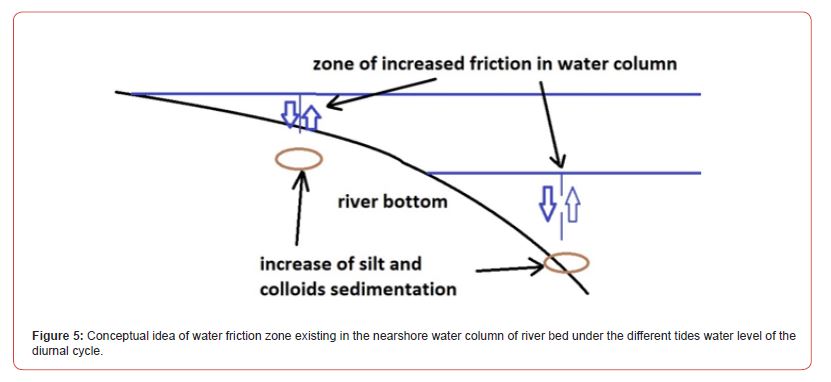
The most of local fishers’ activity on the river is closely related to this phase of the hydrological “stagnation” of the water in the riverbed. Another effect of the tides in the waters of delta estuary rivers is the periodic appearance of nearshore counter-current zones after reaching extreme (high and low) water levels in the river. Due to this phenomenon, an intra-channel friction zone of water masses with opposite flow directions is created in the shore zone. During flood tide, it is located 3-4 m from the bank of the riverbed, and during ebb, it is even more distant (Figure 5). The location of such friction zones in the coastal zone is quite different and depends on the morphology of the river channel. In the case of the Mekong River, which naturally has a high concentration of mineral suspension [12], this results in increased sedimentation of the suspension. Thus, it is next to the front of saline water inflow, another process accelerating the sedimentation of the suspension in the delta branches. It can also be assumed that it is a local and periodic accumulation zone of invertebrate filterers and fish that use a microhabitat with greater potential food availability [13]. This hypothesis needs further detailed research.
Conclusion
The conducted observations and measurements clearly indicate numerous modifications of the freshwater habitat of the river under tide activity. Their considerable range, extending over 300 km inland in the Mekong River Delta, transforms the diurnal productivity rhythm in delta waters compared to the section of the river above the delta. They also indicate the existence of other in-channel zones, increasing the sedimentation of the suspension transported by the river than previously indicated. Modifications of river habitats under the influence of tides result in the formation of numerous micropatches habitats with increased potential for hydrobionts food and maintaining high biodiversity of the delta waters.
Acknowledgments
Research was financed by the Polish National Agency for Academic Exchange (NAWA) with the cooperation of Vietnam National University Ho Chi Minh City, University of Science, Vietnam.
Conflict of Interest
The authors declare no conflict of interest.
References
- Bianchi TS (2002) Biogeochemistry of estuaries. Oxford University Press on Demand, pp. 706.
- Thorp JH, Dodds WK, Robbins CJ, Maasri A, Arsenault ER, et al. (2021) A framework for lotic macrosystem research. Ecosphere 12(2): e03342.
- Le TN, Bregt AK, van Halsema GE, Hellegers PJ GJ, Nguyen LD (2018) Interplay between land-use dynamics and changes in hydrological regime in the Vietnamese Mekong Delta. Land Use Policy 73: 269-280.
- Adamson P, Rutherfurd I, Peel M, Conlan I (2009) The hydrology of the Mekong River. Aquatic Ecol 53-76.
- Hoang LP, Lauri H, Kummu M, Koponen J, Van Vliet MTH, et al. (2016) Mekong River flow and hydrological extremes under climate change, Hydrol Earth Syst Sci 12(11):11651-11687.
- Eslami S, Hoekstra P, Kernkamp H, Nam NT, Dung DD, et al. (2019) Flow Division Dynamics in the Mekong Delta: Application of a 1D-2D Coupled Model. Water 11(4): 837.
- Gugliotta M, Saito Y, Nguyen L, Oanh T, Nakashima R, et al. (2017) Process regime, salinity, morphological, and sedimentary trends along the fluvial to marine transition zone of the mixed-energy Mekong River Delta Vietnam. Continental Shelf Res 147: 7-26.
- Dang T, Ouillon S, Van Vinh G (2018) Water and Suspended Sediment Budgets in the Lower Mekong from High-Frequency Measurements (2009–2016). Water 10(7): 846.
- Takagi H, Nguyen H, Le TA, Nguyen DT, Van PD, et al. (2019) Practical modelling of tidal propagation under fluvial interaction in the Mekong delta. Intern J River Bas Manag 17(3): 377-387.
- Dodds WK (2002) Freshwater ecology: concepts and environmental applications. Academic Press.
- Hoitink AJF, Jay DA (2016) Tidal River dynamics: Implications for deltas. Rev Geophys 54: 240-272.
- Dodds WK, Veach AM, Ruffing CM, Larson DM, Fischer JL, et al. (2013) Abiotic controls and temporal variability of river metabolism: multiyear analyses of Mississippi and Chattahoochee River data. Freshwater Sci 32(4): 1073-1087.
- Bianchi TS, Allison MA (2019) Large-river delta-front estuaries as natural ‘‘recorders’’ of global environmental change. Proc Natl Acad Sci U S A 106(20): 8085-8092.
-
Górniak Andrzej*, Trần Xuân Dũng, Võ Lương Hồng Phước. Tides Effects on Short-Time Freshwater Habitat Modifications of Lower Mekong River Delta (SE Vietnam). Ad Oceanogr & Marine Biol. 3(5): 2024. AOMB.MS.ID.000571.
-
River; delta; ecohydrology; tides effects; phytoplankton; iris publishers; iris publisher’s group
-

This work is licensed under a Creative Commons Attribution-NonCommercial 4.0 International License.






